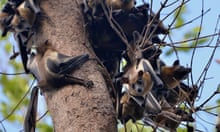Zambia’s capital, Lusaka, was having a power cut, so the only light in the restaurant was from Fumba Chama’s mobile phone. The rapper, better known as PilAto, had just finished uploading a new track to Twitter. The bitter-sweet lyrics (in Bemba) of Yama Chinese describe the concerns of many Zambians: “They put on smart suits and fly to China to sell our country. The roads belong to China. The hotels are for the Chinese. The chicken farms are Chinese. Even the brickworks are Chinese.”

PilAto (an acronym for “people in the lyrical area taking over”) is a voice for Zambia’s voiceless. In May 2018 he returned from six months’ self-imposed exile in South Africa, where he had fled after death threats over another rap, Koswe Mumpoto (Rat in the Pot), denouncing corruption in President Edgar Lungu’s government.
Resentment of China is growing, especially in the copperbelt region, which generates 70% of Zambia’s export earnings. The government is widely criticised over its social policies. Cosmas Mukuka, secretary general of the Zambia Congress of Trade Unions, told me that some private Chinese companies operating in Zambia, hiding in the shadow of the mining multinationals, “are not following the recommendations of the International Labour Organization”.
In December 2018 John Bolton, then US national security adviser and responsible for revealing Washington’s new Africa strategy, claimed that China planned to take over some state-owned enterprises if the Zambian government defaulted on its debt. This was a reference to an article published three months earlier in the Africa Confidential newsletter, claiming that the state electricity company, Zesco, was “in talks about a takeover by a Chinese company”, which raised concerns about “national sovereignty and Chinese ownership of key components of the country’s infrastructure”.
Zambia’s external debt, currently estimated at 35% of its GDP, has soared: according to official figures it reached nearly $10bn in 2018, up from $1.9bn in 2011. As southern Africa’s third-largest economy and Africa’s second-largest producer of copper, Zambia is a textbook case of the Chinese debt trap that affects 15 African countries, including Djibouti and the Democratic Republic of the Congo.

At a conference on China’s Belt and Road initiative in Beijing in April 2018, Christine Lagarde, then the International Monetary Fund’s (IMF) managing director, recognised that Chinese aid could help with Africa’s pressing need for infrastructure and finance, but noted that intergovernmental partnerships “can also lead to a problematic increase in debt, potentially limiting other spending as debt service rises”. The IMF rejected Zambia’s request for a loan of $1.3bn, since “the borrowing plans provided by the authorities continue to compromise the country’s debt sustainability and risk undermining its macroeconomic stability”.
The Zambian government accuses the IMF of disinformation. Bowman Lusambo, minister for Lusaka province, which is twinned with China’s Sichuan province, said that the US, obsessed with its trade war with China, is smearing Zambia with the support of international financial institutions. Government data confirms that China controls 30% of Zambia’s external debt, while most of the rest is in the hands of multilateral or commercial creditors, or on the international bond markets.
But according to Joseph Mwenda, editor of independent daily newspaper News Diggers!, “the official figures reflect only part of reality: some loans granted by China haven’t been taken into account, because work on the projects they finance has not yet started”. Moreover, many contracts with foreign operators are thought to have been overbilled. The US-based Brookings Institution estimated in September that loans from China accounted for 65.8% of Zambia’s external debt, an African record.

African countries have been through a calmer period because of rising global commodity prices that have allowed them to replenish their coffers, but now many are back in debt. In the 1980s and 90s almost all had to sign up to disastrous structural adjustment programmes required by international financial institutions to reduce their indebtedness; in order to receive financial aid, they had to agree to neoliberal and free trade policies.
But where debt was once a symptom of western capitalist domination, it is now also a sign of China’s grip on countries desperately in need of infrastructure and procuring funds through non-concessional loans. These are now thought to account for 77% of Zambia’s total debt, compared with 23% in 2011.
The World Bank and IMF protest, forgetting their responsibility for Zambia’s past difficulties. Between 2002 and 2008 the value of Zambia’s mineral exports grew 500%, from $670m to $4bn, but did not boost its tax revenue. Western and Indian commodity giants were exempted from taxation on the recommendation of the IMF, which advocates fiscal competition.
So, Zambia called on its friend of 40 years, China, for help in financing infrastructure. The IMF did not object at the time.

Debt spiral
This began a new debt spiral. In 2012, following the example of other African countries and encouraged by the IMF, Zambia issued its first eurobond — $750m with a 10-year term and a yield of 5.65% — on the international financial markets. This sovereign debt issue was sub-Saharan Africa’s most successful, attracting 15 times the target amount, initially from US investment and pension funds.
In 2014, when the commodities “supercycle” slowed, Zambia issued another eurobond, for $1bn, supported by the IMF and managed by Deutsche Bank and Barclays. The yield on another eurobond ($1.25bn, 11 years), issued in 2015, was 9.375%, the highest paid in seven years by a sub-Saharan country for an operation of this kind.

As Zambia began to repay its eurobonds, the government continued to borrow from China to finance the Kafue Gorge hydroelectric dam, a $1.5bn project that aroused US concerns over the future of Zesco.
Zambia’s debt could reach $11.4bn in 2019, according to the IMF, which warns that the country is “at high risk of debt distress”. Lubinda Haabazoka, president of the Economics Association of Zambia, said: “It’s the $3bn worth of eurobonds that are the problem, not the Chinese loans. Servicing our debt will cost us $800m this year, and $300m of that is for the eurobonds. And with eurobonds, you don’t play around when the payments are due. Chinese debt can easily be renegotiated, restructured or refinanced.”
Interest on the eurobonds has topped 10%. Haabazoka, who advises President Lungu, advocates renationalising the mines and asking a Turkish investment fund to refinance the eurobonds.
The irony is that Zesco was included in the privatisations recommended by the IMF in the early 2000s. It has a 30% stake in Sinozam Power Corporation, which is building the Kafue Gorge dam; Chinese engineering firm Sinohydro and the China-Africa Development Fund hold 50% and 20%. It is through such ad hoc mutual debt funds, set up to serve the public-private partnerships the IMF loves, that China could take control of Zesco if Zambia defaults on its debt.

Tragic irony
TopStar’s head office is in Lusaka. In the lobby, TV screens were showing a kung fu film, a Nigerian drama series, a Turkish series, a Zambian talkshow, a Ligue 1 football match and a Chinese series dubbed into Swahili. The TopStar mutual debt fund, founded in 2016 by the Zambia National Broadcasting Corporation (ZNBC) and private Chinese operator StarTimes to handle Zambian national television’s migration from analogue to digital, has 15 Chinese employees and 130 Zambians.
StarTimes is the only privately owned Chinese company allowed to invest in the foreign radio and television market, and is conquering Africa’s digital terrestrial television market. In September 2018 it hosted a Forum on China-Africa Cooperation summit in Beijing, attended by 18 African heads of state.
But TopStar’s vice-president, Cliff Sichone, described claims that China controlled ZNBC as “unfounded”. (John Bolton had claimed the public broadcaster was already Chinese owned.) According to the China Africa Research Initiative blog, hosted by the Johns Hopkins School of Advanced International Studies in Washington DC, “the takeover of the public broadcaster by a foreign entity would require the amendment of the Zambia National Broadcasting Corporation Act, something which would not easily pass through parliament without a lot of publicity”.











